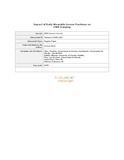Mostrar el registro sencillo del ítem
Impact of body wearable sensor positions on UWB ranging
| dc.creator | Otim, Timothy | es_ES |
| dc.creator | Bahillo, Alfonso | es_ES |
| dc.creator | Díez, Luis E. | es_ES |
| dc.creator | López Iturri, Peio | es_ES |
| dc.creator | Falcone Lanas, Francisco Javier | es_ES |
| dc.date.accessioned | 2020-06-05T10:28:33Z | |
| dc.date.available | 2020-08-20T23:00:14Z | |
| dc.date.issued | 2019 | |
| dc.identifier.citation | T. Otim, A. Bahillo, L. E. Díez, P. Lopez-Iturri and F. Falcone, 'Impact of Body Wearable Sensor Positions on UWB Ranging,' in IEEE Sensors Journal, vol. 19, no. 23, pp. 11449-11457, 1 Dec.1, 2019, doi: 10.1109/JSEN.2019.2935634. | en |
| dc.identifier.issn | 1530-437X | |
| dc.identifier.uri | https://hdl.handle.net/2454/37094 | |
| dc.description.abstract | In recent years, Ultrawideband (UWB) has become a very popular technology for time of flight (TOF) based localization and tracking applications but its human body interactions have not been studied yet extensively. Most UWB systems already proposed for pedestrian ranging have only been individually evaluated for a particular wearable sensor position. It is observed that wearable sensors mounted on or close to the human body can raise line-of-sight (LOS), quasi-line-of-sight (QLOS), and non-line-of-sight (NLOS) scenarios leading to significant ranging errors depending on the relative heading angle (RHA) between the pedestrian, wearable sensor, and anchors. In this paper, it is presented that not only does the ranging error depend on the RHA, but on the position of the wearable sensors on the pedestrian. Seven wearable sensor locations namely, fore-head, hand, chest, wrist, arm, thigh and ankle are evaluated and a fair comparison is made through extensive measurements and experiments in a multipath environment. Using the direction in which the pedestrian is facing, the RHA between the pedestrian, wearable sensor, and anchors is computed. For each wearable sensor location, an UWB ranging error model with respect to the human body shadowing effect is proposed. A final conclusion is drawn that among the aforementioned wearable locations, the fore-head provides the best range estimate because it is able to set low mean range errors of about 20 cm in multipath conditions. The fore-head's performance is followed by the hand, wrist, ankle, arm, thigh, and chest in that order. | en |
| dc.description.sponsorship | This work was supported in part by the Research Training Grants Program of the University of Deusto, in part by REPNIN+ under Grant TEC2017-90808-REDT and in part by Ministerio de Ciencia, Innovación y Universidades, Gobierno de España under Grant RTI2018-095499-B-C31. | en |
| dc.format.extent | 32 p. | |
| dc.format.mimetype | application/pdf | en |
| dc.language.iso | eng | en |
| dc.publisher | IEEE | en |
| dc.relation.ispartof | IEEE Sensors Journal, 2019, 19 (23), 11449-11457 | en |
| dc.rights | © 2019 IEEE. Personal use of this material is permitted. Permission from IEEE must be obtained for all other uses, in any current or future media, including reprinting/republishing this material for advertising or promotional purposes, creating new collective works, for resale or redistribution to servers or lists, or reuse of any copyrighted component of this work in other work. | en |
| dc.subject | Ultrawideband (UWB) | en |
| dc.subject | Time of flight (TOF) | en |
| dc.subject | Ranging | en |
| dc.subject | Human body shadowing | en |
| dc.subject | Wearable sensors | en |
| dc.title | Impact of body wearable sensor positions on UWB ranging | en |
| dc.type | info:eu-repo/semantics/article | en |
| dc.type | Artículo / Artikulua | es |
| dc.contributor.department | Ingeniería Eléctrica, Electrónica y de Comunicación | es_ES |
| dc.contributor.department | Ingeniaritza Elektrikoa, Elektronikoa eta Telekomunikazio Ingeniaritza | eu |
| dc.contributor.department | Institute of Smart Cities - ISC | es_ES |
| dc.rights.accessRights | info:eu-repo/semantics/openAccess | en |
| dc.rights.accessRights | Acceso abierto / Sarbide irekia | es |
| dc.embargo.terms | 2020-08-20 | |
| dc.identifier.doi | 10.1109/JSEN.2019.2935634 | |
| dc.relation.projectID | info:eu-repo/grantAgreement/ES/2PE/TEC2017-90808 | en |
| dc.relation.publisherversion | https://doi.org/10.1109/JSEN.2019.2935634 | |
| dc.type.version | info:eu-repo/semantics/acceptedVersion | en |
| dc.type.version | Versión aceptada / Onetsi den bertsioa | es |


